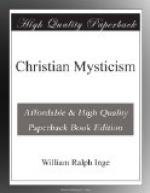Erotic Mysticism is no part of Platonism. That “sensuous love of the unseen” (as Pater calls it), which the Platonist often seems to aim at, has more of admiration and less of tenderness than the emotion which we have now to consider. The notion of a spiritual marriage between God and the soul seems to have come from the Greek Mysteries, through the Alexandrian Jews and Gnostics. Representations of “marriages of gods” were common at the Mysteries, especially at those of the least reputable kind (cf. Lucian, Alexander, 38). In other instances the ceremony of initiation was made to resemble a marriage, and the [Greek: mystes] was greeted with the words [Greek: chaire, nymphie]. And among the Jews of the first century there existed a system of Mysteries, probably copied from Eleusis. They had their greater and their lesser Mysteries, and we hear that among their secret doctrines was “marriage with God.” In Philo we find strange and fantastic speculations on this subject. For instance, he argues that as the Bible does not mention Abraham, Jacob, and Moses as [Greek: gnorizontas tas gynaikas], we are meant to believe that their children were not born naturally. But he allegorises the women of the Pentateuch in such a way ([Greek: logo men eisi gynaikes, ergo de aretai]) that it is difficult to say what he wishes us to believe in a literal sense. The Valentinian Gnostics seem to have talked much of “spiritual marriage,” and it was from them that Origen got the idea of elaborating the conception. But, curiously enough, it is Tertullian who first argues that the body as well as the soul is the bride of Christ. “If the soul is the bride,” he says, “the flesh is the dowry” (de Resurr. 63). Origen, however, really began the mischief in his homilies and commentary on the Song of Solomon. The prologue of the commentary in Rufinus commences as follows: “Epithalamium libellus hic, id est nuptiale carmen, dramatis in modum mihi videtur a Salomone conscriptus, quem cecinit instar nubentis sponsae, et erga sponsum suum qui est sermo Dei caelesti amore flagrantis. Adamavit enim eum sive anima, quae ad imaginem eius facta est, sive ecclesia.” Harnack says that Gregory of Nyssa exhibits the conception in its purest and most attractive form in the East, and adds, “We can point to very few Greek Fathers in whom the figure does not occur.” (There is a learned note on the subject by Louis de Leon, which corroborates this statement of Harnack. He refers to Chrysostom, Theodoret, Irenaeus, Hilary, Cyprian, Augustine, Tertullian, Ignatius, Gregory of Nyssa, Cyril, Leo, Photius, and Theophylact as calling Christ the bridegroom of souls.) In the West, we find it in Ambrose, less prominently in Augustine and Jerome. Dionysius seizes on the phrase of Ignatius, “My love has been crucified,” to justify erotic imagery in devotional writing.




